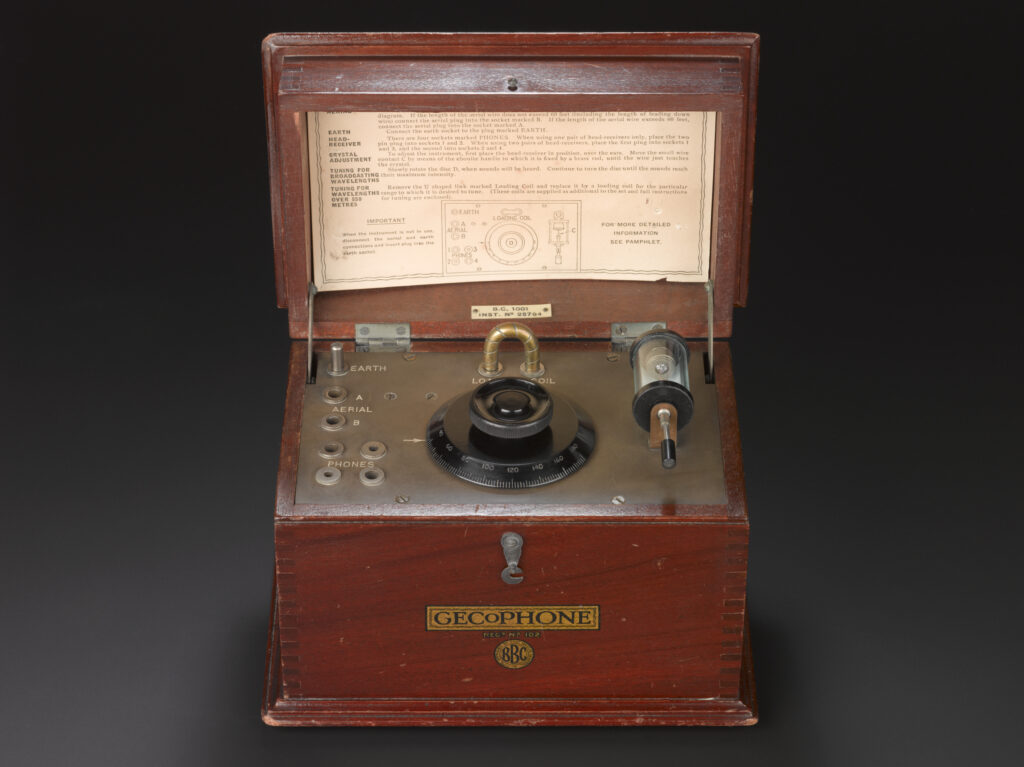2014 may have been the year Taylor Swift released 1989, Ellen DeGeneres took that epic selfie at the Oscars, and Uber Eats launched a pilot food delivery service, but something just as exciting happened at the Science Museum: the Information Age gallery opened on 24 October 2014!
The gallery tells the story of 200 years of information and communication technologies. Arranged into six ‘networks’ – cable, broadcast, exchange, constellation, web and cell – each area presents the technologies and infrastructure alongside the extraordinary stories of the people who created, used and were affected by each new wave of change.

The cable
The first Information Age section explores the development of the telegraph network and how the increased speed of information it enabled impacted society, culture and commerce. It includes the dramatic tale behind the first transatlantic telegraph cable laid between the west coast of Ireland and Newfoundland in the 1850s.
Hampered by technical woes, broken cables and an interested whale, the USA and Europe were finally successfully linked together in 1866, laying the foundation of the worldwide network of submarine cables.
In the years since, the kinds of cables we use, and the transmissions speeds, have advanced considerably. Today, more than 90% of internet data travels over undersea fibreoptic cables with 10% transmitted by satellite. The number of places that are connected to the internet via undersea cables has also continued to grow.
Most recently, in January of this year, cables connected the Kochi-Lakshadweep Islands off the west coast of India. With many cable routes following those established in the nineteenth century there is more for governments and private companies to do to make the world truly connected. This map illustrates how the world is connected via subsea cables.


The Broadcast
The section on Broadcast looks at the mass adoption of radio and television which connected people to news and global events in a new way. Alongside the launch of the BBC in 1922, this section highlights the specialist skills of amateur radio operators in the 1920s and 1930s who encouraged the adoption of this new form of communication through clubs and communities.
Popular magazines were established for the enthusiastic radio operators, or ‘hams’, and conventions and etiquette around radio communication began to appear. The same conventions were followed by amateur radio operators into the 21st century.
Today, the ways we watch are increasingly ‘on demand’ streaming services, which rely on internet connection, rather than via satellite TV. This has vastly increased the amount of content available and changing viewing behaviours with algorithmically driven personalized recommendations and flexible viewing options.
The same shift has also been happening with radio, although without the same level of uptake. Digital Audio Broadcasting (DAB) was made available in the UK in 1995. Its popularity showed an uptick after the introduction of BBC Radio 4 Extra in 2002, and today many radio receivers have capacity for both FM and DAB.


The Exchange
The exchange tells the story of the telephone, from the race to patent the invention in 1876 to becoming a global communication infrastructure, through the people who developed, managed and used this technology.
One of the key telecommunication developments has been the introduction of the Integrated Services Digital Network (ISDN). This happened in the 1980s in the UK and allowed for digital transmission through the analogue cables of the Public Switched Telephone Network (PSTN). This meant that a combination of digital (fibre) cables, and analogue (copper) cables could be used together to deliver internet services.
In the last years, there has been a push to move away from this hybrid service and to switch to entirely digital networks. BT have announced that by the end of 2025, all PSTN and ISDN services will be switched off in the UK. This will mark a historic moment, when the technology that these analogue lines use of ‘circuit switching’, which has been used since the introduction of electric telegraphy in 1837, will come to an end.


The Constellation
This section of the gallery explores how satellites allow us to collect and use data in new ways.
In 1961 a windswept Cornish moor was chosen as the location to receive signals from space. Goonhilly Earth Station is a large satellite communications site, chosen for its westerly location and view of the across the Atlantic. Built for the Telstar broadcast (the first live transatlantic television broadcast between two continents via an artificial satellite), Goonhilly helped ignite the white heat of technology, broadcasting the 1964 Olympics and the Moon landings in 1969.
Satellite constellations, or swarms, are networks of satellites working together towards the same purpose. They enable many of the other technologies present in the gallery, including telecommunications, internet connection, as well as data collection for things like climate modelling.
Networks like these were launched as early as the 1960s but have seen advances in recent years. While most ‘constellations’ have tens of satellites working together, Starlink, which enables internet connection, has grown to include over five thousand satellites since the first deployment in 2019.


The Web
The Web area of the gallery explores how computer networks have enabled global connectivity and information sharing.
Today 8.32 billion e-mails are sent from the UK connecting people all over the world. The humble beginnings of this significant communication technology started in 1969 thanks to ARPANET, a precursor to the Internet and the first network that used packet switching to send information quickly and reliably between computers.
Initially connecting network nodes on the west coast of the United States, it grew rapidly in the 1970s, largely due to an enthusiastic community of users who directed its main functions away from resource sharing to more creative forms of communication, including the first e-mail sent by Ray Tomlinson in 1971.
The number of people with Internet access and able to engage with the Web has grown globally in the last decade. In the UK around 98% of the population have access to the internet, up from 87% in 2014. Along with these increased internet access and speeds, we are becoming more accustomed to the ‘Internet of Things’ where objects and appliances have internet connectivity.
The Amazon Alexa, which also employs AI technology, was released in 2015 introducing the Smart Speaker into the home, had sold over 100 million devices by 2019. Internet technology is now used frequently in objects as varied as watches, thermostats, doorbells, and even toys!


The Cell
The Cell zone of the gallery focuses on how the development of mobile phones has transformed the ways we communicate on the move.
2014, when these galleries opened, was the year the iPhone 6 and BlackBerry Classic were released. The smartphones available at that time were already miles ahead of the ‘bricks’ of the 1980s. Even still, the advances in the last decade have been immense – and many of us walk around with mobile phones which have the computing power of the supercomputers of the past in our pockets.
Along with this, the broader rollout of 4G technology (first released in 2012), and more recently 5G, have increased internet speeds on-the-go, in turn meaning many of us use internet-enabled apps to call or message, rather than using cellular networks.


The Information Age: the next decade
The information age continues to rapidly grow, shaping our lives through faster, smaller and more mobile forms of technology.
The developments over the last decade point to an increasingly connected and data-rich world, where digital and internet technologies dominate.
With research at the forefront of Artificial Intelligence, Augmented Reality, more powerful computer processors, and wearable technologies, it is safe to assume that the next ten years will see even more change to the ways we communicate, and how data is produced and shared.
What are your predictions for the future of your information age?